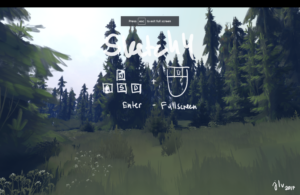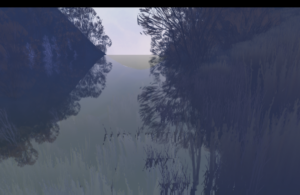Places
This week, I explored Places and walked around in Sketch 4, Sketch 5, Place 5, and Place 6. All these walking simulators can be accessed on http://jlv.fi/places/, but the creator of the platform seems to want to stay anonymous.
The target audience of Places, similar to other walking simulators, are players who do not have much gaming experience. This can range from young children to older adults. Of course, experienced gamers can also enjoy Places; walking simulators are suitable for any player who wants to walk around in an immersive environment.

Analysis of Formal Elements + Types of Fun
- Environmental storytelling: As 3D paintings that players can walk around in, Places uses game environments and atmospheres themselves to tell stories. Specifically, in Place 6, the player emerges on a hill full of trees, grass, and bushes. The setting is very serene, and the player can discover a river to swim in as they explore. The first-person point of view and visual details, such as the shadows and reflections of the trees on the river, add realism to the environment which results in an overall immersive experience.
- Sound: In addition to graphic design, sound design is the other major contributor to the immersive experience. When the player walks through a forest, they can hear the bushes and grass rustle. When the player swims in the river, they can hear themselves splashing and the bubbling of the water. Sound design contributes to the sensation of Places, and this sensation makes the player feel as if they were actually momentarily transported into a forest.
- Player autonomy: Players in Places are given full freedom to explore however they want which encourages discovery. The only limitation is when the player reaches the boundary of the environment. This autonomy creates a non-linear narrative that enables players to discover and learn more about the environment in an organic way at their own pace.
- Simple gameplay: Although the environmental and sound design in response to player interaction is quite complex, the actions that players can take in Places is pretty simple. Players can walk around in the environment, and that’s all there is to it. There are no tasks or challenges to complete, and there is no linear plot line that guides the player to go to certain places. Places requires minimal mental bandwidth to play, so players can explore in submission.

Competitors
Places competes with other games in the genre of walking simulators such as The Stanley Parable. However, the main difference is that The Stanley Parable offers a more concrete narrative that branches into multiple paths depending on the player’s choices. Places is better suited for players who want to transport themselves into another environment rather than players who want a narrative.
Conclusion + Improvements
Overall, Places is an awesome sensory, immersive experience, similar to virtual reality environments. Personally, I believe Places would be more engaging if there were hidden clues that players can find that would lead them to new discoveries. Otherwise, players could get bored within minutes of exploration.



